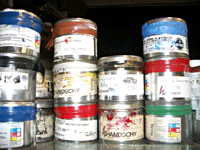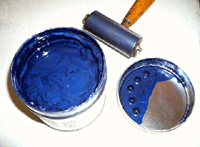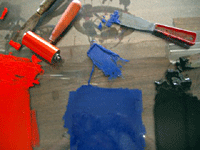original printmaking processes



An image is made using inks (I like to use oil based inks) on a non-absorbent surface such as Plexiglas or metal. The image is then transferred to paper with the use of a press. The monotype is a unique print made by means that permits only one impression and cannot be duplicated.
Relief Printmaking
The artist cuts away the areas which are to appear white in the final
print using knives and gouges. The printing image is on top of the surface
block. The negative area are carved away by the artist. Ink is applied
with rollers or brayers to the flat upper surface of the block, then paper
laid on the block and rubbed with a baren or spoon, or pressure is applied
with a press.
Linocut and Woodcut
Made by cutting into the broad face of a plank of wood. A linocut is
worked in the same manner except that linoleum is substituted for wood.
Wood Engraving
Made by cutting into the end grain of the wood. The block being much
harder than the plank used for woodcut, enables the artist to work a much
finer line than in woodcut.
Collagraph
A collagraph is a collage of tactile and relief textures on a back plate
which when inked and printed will exaggerate the relief and transmit it
to paper creating a rich and varied surface. The back plate could be cardboard,
metal, wood or plastic.
Chine-collé
I like to use this printing method with all my collagraphs. Chine-collé
enables you to place pieces of colored paper, cut or torn to a desired
shape, into proper position on your plate and then print the paper and
the image together. The procedure of chine-collé is simple, but
it must be done with no wasted time at the critical point of gluing.
Intaglio
Metal or plastic plate is incised by various methods described below.
Ink is then pushed into the incised areas and the surface of the plate
is wiped clean. Damp paper is placed over the plate and covered with soft
felt blankets, run through high pressure etching press. The fibers of
the paper are forced into the recesses of the plate to pick up the ink.
Engraving
The metal plate is carved directly with a burin.
Drypoint
The lines are scratched into the surface of the plate, raising a ridge
of metal next to the line called a burr. The burr catches and holds the
ink in an irregular manner, giving a soft velvety appearance to the line.
Mezzotint
The entire surface of the plate is methodically roughened with a tool
called rocker. The image is developed by scraping and polishing the rough
surface, working from black to white.
Etching
A zinc or copper plate is coated with an acid resistant wax-based material
called ground. The image is drawn with a needle which removes the ground
exposing the metal. The plate is then placed in an acid bath where the
exposed metal is etched, or eaten away.
Aquatint
The metal plate is covered with an even layer of fine dots of acid resist
material. The areas of exposed metal between the dots are eaten away in
the etch, and will print an even tone of pale gray to deep black, depending
on how long the plate was left in the acid.
Viscosity
The plate is made by etching or collagraph technique. Inking of the plate
is done in the intaglio manner for the first color. A second color is
applied to the highest surfaces of the plate with a hard roller, using
very oily inks. A third color is applied with a soft roller using a very
dry ink. This third color does not mix with the oily surface and sticks
only to lower levels of the plate. All three colors are applied to the
plate prior to printing.
Embossing
The paper molds to the shape of the plate or block, whether worked by
relief or intaglio methods. Blind embossing refers to printing the plate
without the use of ink.
Lithography
The artist draws or paints directly on the litho stone with greasy materials.
The grease in the design is chemically fixed to the surface in a process
called “the etch." The stone is dampened with water, and oil-base
ink is applied with a roller. The ink will cling to the greasy design
but not to the wet stone. Paper is pressed against the stone in a scraping,
sliding pressure by pulling it through a lithographic press.
Serigraph or Silkscreen
The artist prepares a tightly stretched screen of silk or nylon on a hinged
frame. The design is placed on the screen by filling up the mesh of the
cloth with glue or varnish, or by adhering paper or plastic to the undersurface
of the screen. The printing paper is placed under the screen, and ink
is forced through the open areas of the mesh onto the paper.
|
Home • Recent
Work • Monotype-Still Life
• Monotype-Landscape •
Linocuts Intaglio • Collagraphs • Vinita Voogd Biography & Exhibitions About Printmaking & Links • Artist's Statement • Contact the Artist |
| All artwork © Vinita Voogd |